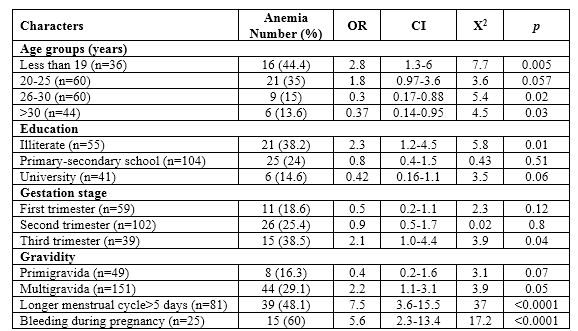Prevalence and risk factors for anemia during pregnancy in Sana'a city
Main Article Content
Abstract
Background: A common issue during pregnancy is anemia, which is defined as a decline in the blood's ability to carry oxygen, mainly as a result of lower hemoglobin levels. There are two possible types of declines: absolute and relative. It is well known that the most prevalent nutritional condition is iron deficiency.
Objective: In order to ascertain the prevalence of anemia and related risk factors among pregnant women in Sana'a, Yemen, a cross-sectional study was conducted.
Subjects and methods: Two hundreds pregnant women between the ages of 17 and 40 years participated in this study. Calculations were made for socio-demographic, menstrual history, and haematological characteristics. Platelet counts were ascertained along with anemia proxies such as hemoglobin (HB), hematocrit (HCT), mean corpuscular volume (MCV), packed cell volume (PCV), mean corpuscular hemoglobin (MCH), and mean corpuscular hemoglobin concentration (MCHC).
Results: The mean hemoglobin level among our pregnant females was 12.8 mg/dL, with 26% diagnosed with anemia (<11.9 mg/dL). Notably, 38% of patients exhibited PCV levels below the norm, while none in >46 PCV (above the normal level). The average RBC count stood at 4.5 cells x 106/μl, ranging from 3.6 to 5.9 cells x 106/μl, with none falling below the normal range for adult females. The mean MCV was 81.3 fl, with 34% displaying microcytic anemia (<80 fl). Additionally, the mean MCH was 28.3 p/cell, with 22% experiencing iron deficiency anemia and 8% showing elevated counts (>31 p/cell) suggestive of anemia due to low folic acid or vitamin B12 levels. The mean MCHC was 34.6 g/dl, with 18% having levels exceeding 36 g/dl, indicating anemia. Age played a significant role, with anemia being notably associated with those under 19 years, exhibiting an odds ratio of 2.8. Other significant associations included illiteracy (OR = 2.3, p =0.01), being in the third trimester (OR=2.1, p=0.04), multigravida (OR=2.2, p=0.05), having a menstrual cycle longer than 5 days (OR=7.5, p <0.0001), and experiencing bleeding during pregnancy (OR=5.6, p<0.0001).
Conclusion: The prevalence of anemia during pregnancy among Yemeni pregnant women was moderate, but at a significant rate. Multigravidy and the third trimester were associated risk factors with a higher incidence of anemia during pregnancy. Other risk factors were women younger than 19 years, a longer menstrual cycle >5 days, bleeding during pregnancy, and a low level of education.
Downloads
Article Details

This work is licensed under a Creative Commons Attribution-NonCommercial-NoDerivatives 4.0 International License.

